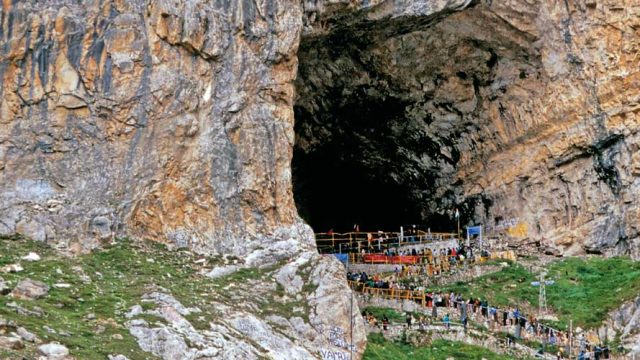In Hinduism, there are strong links between the silvery Himalayan peaks and Lord Shiva. Traversing heights of over 14,000ft, this arduous trek is worth the effort since the pilgrimage takes you to the unique ice shivalinga. This formation is extraordinarily huge, a perfectly shaped swayambhu (self-manifested) shivalinga that never fails to convince pilgrims of Amarnath’s divinity. The source, being the holy Ramkund Lake, is situated above the cave. The Amarnath trail is along thick and green woodlands of breathtaking beauty, with the Lidder River meandering alongside. It is considered veryauspicious to bathe in the Sheshnag Lake. The trek up the Pissu Ghati is the formidable climb from Sheshnag to the Mahagunas Top (15,091ft). This 5-km climb leads to the highest point of the pilgrimage, the Amarnath Shrine which is considered one of the holiest of Hindu temples.

THINGS TO SEE AND DO
Amarnath Shrine
Trek Route (from Pahalgam): Pahalgam-Chandanwari (16km) – Pissu Top (4km) – Sheshnag (9km) – Mahagunas (5km) – Panchtarni (8km) – Amarnath Cave (6km). The Pahalgam route is considered the more sacred route. The base camp is in Nunwan, 3km before Pahalgam. Early in the morning, pilgrims are allowed to proceed from Nunwan and Pahalgam to Chandanwari, a distance of 16km, by mini-buses and taxis. From Chandanwari onwards, the track gets even steeper, and is accessible only on foot or by pony (return ₹4,500 approximately) or dandi (palki, return ₹17,000 approximately). Porters can also accompany pilgrims (return ₹2,500 approximately).
(From Baltal) Baltal–Domail (2km) – Burari Marg (5km) – Sangam Ghati (5km) – Amarnath Cave (3km). The Baltal route is shorter but steeper and prone to landslides. The entire 15km stretch has to be covered in a single day since there is no overnight accommodation available between Baltal and the holy cave. Typical costs along this route are ₹3,000 return by pony, ₹8,500 (approximately) return by dandi (palki) and ₹1,650 for porters.
WHERE TO STAY
Tented accommodation is available here. Night halts on the Baltal route are at Manigam, Baltal and Panchtarni (₹100– 400 per night) and at Nunwan, Chandanwari, Sheshnag (₹125–280 per night) and Panchtarni on the Pahalgam route.
WHERE TO EAT
The langars (community kitchens) set up by Shiva sevak mandals and samitis dot the entire trek and provide food and basic medication, accommodation andsanitation facilities serving paranthas, milk, biscuits, dal, rice, sweets, dosa, kheer, tea and bread.
Tip Smoking and drinking alcohol are strictly prohibited on the yatra. Only vegetarian meals are served n 32
THE INFORMATION
When to go The Yatra usually begins around mid-July and ends in mid-August
Health Certificate
It is mandatory for yatris to obtain a Compulsory Health Certificate from the authorized medical agencies. Check the list of authorized doctors/ medical insti-tutions on W shriamarnathjishrine.com
Shri Amarnathji Shrine Board, Help Desk, Srinagar. Tel: 0194-2501679, Email: sasbjk2001@gmail.com, W shriamarnathijshrine.com, STD code 1936
GETTING THERE
Air Nearest airport: Srinagar (Pahalgam 96km, Baltal 93km). Average cost of a taxi to either Pahalgam or Baltal is about ₹4,000–5,000 depending on the vehicle. Rates should be confirmed close to the yatra dates.A helicopter service (W pawanhans.co.in, W onlineglobalhelicorp. com) ferries devotees from Pahalgam or Baltal to Panchtarni, removing many stages of the trek
Rail Nearest railhead: Jammu Tawi (319km/ 7hrs)




